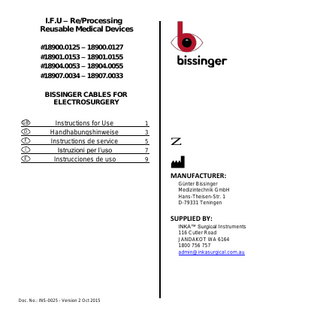Gunter Bissinger Medizintechnik
bissinger Electrosurgery Cables 1890x.xxxx Instructions for Use
6 Pages

Preview
Page 1
I.F.U – Re/Processing Reusable Medical Devices #18900.0125 – 18900.0127 #18901.0153 – 18901.0155 #18904.0053 – 18904.0055 #18907.0034 – 18907.0033 BISSINGER CABLES FOR ELECTROSURGERY GB D F I E
Instructions for Use Handhabungshinweise Instructions de service Istruzioni per l’uso Instrucciones de uso
1 3 5
Z
7 9
MANUFACTURER: Günter Bissinger Medizintechnik GmbH Hans-Theisen-Str. 1 D-79331 Teningen
SUPPLIED BY: INKA™ Surgical Instruments 116 Cutler Road JANDAKOT WA 6164 1800 756 757 [email protected]
Doc. No.: INS-0025 - Version 2 Oct 2015
ENGLISH
Drying Dry the cables by carrying out a drying cycle of the cleaning/disinfection machine. If necessary, manual drying may additionally be carried out using a lint free cloth. Dry cavities by blowing with sterile, compressed air.
Bissinger Cables for electrosurgery
Caution Please read all information contained in this insert. Incorrect handling and care as well as misuse can lead to premature wear of surgical instruments.
Manual reprocessing Cleaning Prepare a cleaning bath according to the manufacturer’s instructions. 1. Rinse products with cold tap water (<40°C) until all visible accumulations of dirt have been removed. Remove stuck dirt by using a soft brush. 2. Place products in the prepared cleaning bath so that they are completely submersed. Observe residence time according to the manufacturer’s instructions. 3. Clean the cable in the bath manually using a soft brush. Brush all surfaces several times. 4. Rinse the products thoroughly with running tap water to remove the cleaning agents without residue.
Indications for Use Cables for electrosurgery are designed either to conduct electrical power from the output of a high-frequency generator to the instrument or to connect a neutral electrode with the generator. Attention: Instruments and cables for electrosurgery should be used only by persons who have been specially trained in the use of such instruments. Use and safety instructions - All cables have to be completely cleaned, disinfected and sterilised before initial use and any other use. - The cables have to be submitted to a visual inspection and a functional test before each use. - Never use damaged cables. - Store the cables in a clean, cool and dry place. Protect them from damage. - Handle the cables with care, and do not pinch them. - Make sure that the cable is correctly inserted in the socket or connected with the plug.
Disinfection Prepare a disinfectant bath according to the instructions of the disinfectant manufacturer. Place the cables in the disinfectant bath and observe the specified residence time. Rinse the cables thoroughly with fully demineralised water to remove the disinfectant without residue.
Reprocessing Preparation and transport Remove coarse dirt from the cables immediately after each use. Do not use fixation agents or hot water (>40°C).
Drying Dry manually by using a lint free cloth and, in particular, for drying cavities, sterile compressed air. Functional test and packaging Perform visual inspection for cleanliness. If necessary, repeat the reprocessing process until the instrument is optically clean. Packaging has to comply with ISO 11607 and EN 868 standards for packaging for sterilised instruments.
Machine reprocessing Cleaning Place the cables in a basket on the insert module or on the inserts of the MIS module and start the cleaning process. 1. Prerinse for 1 min. with cold water 2. Discharging 3. Prerinse for 3 min. with cold water 4. Discharging 5. Wash for 5 min. at 55°C with a 0.5% alkaline or at 45°C with an enzymatic cleaning agent. 6. Discharging 7. Neutralise for 3 min. with warm tap water (>40°C) and a neutralising agent. 8. Discharging 9. Rinse for 2 min. with warm tap water (>40°C). 10. Discharging
Sterilisation Sterilisation of the products with fractional pre-vacuum procedure (in accordance with ISO 13060 / ISO 17665) in consideration of the respective national requirements. - 3 pre-vacuum phases with a pressure of at least 60 mbar. - Heating up to a sterilisation temperature of min. 132°C and max. 137°C - Shortest exposure time: 3 min. - Drying time: at least 10 min. Information on the validation of the reconditioning The following testing instructions, materials and equipment have been used for validation:
Disinfection Machine operated thermal disinfection has to be carried out in consideration of the national requirements with regard to the A0 value (see ISO 15883).
Cleaning agents (for machine use): Neodisher FA by Dr. Weigert (alkaline) Endozime by Ruhof (enzymatic) Cleaning agents (manual cleaning): Enzol Enzym, detergent by Johnson&Johnson Neutralising agent: Neodisher Z by Dr. Weigert Cleaning and disinfection device: Miele G 7736 CD Miele insert module E 327-06 Miele MIS module E 450
Unsterile Attention: According to US-laws, this device must only be sold by a doctor or on the instruction of a doctor.
For details, see report. SMP GmbH # 01707011901-2 (machine cleaning) Northview Laboratories #P8H066 (manual cleaning, sterilisation) Nelson Labs # 200432706-02 (sterilisation) MDS GmbH Testbericht 084183-10 (Sterilisation) If the chemicals and machines described above are not available, the user has to validate the used process accordingly.
Handling During transport, cleaning, care, sterilisation and storage, all cables should be handled with maximum care. Warranty Guenter Bissinger Medizintechnik GmbH exclusively supplies tested and faultless products to the customers. All products are designed and manufactured to comply with maximum quality requirements. We refuse any liability for products which, compared to the original product, have been modified, misused or handled or used in an inexpert way. Explanation of symbols Batch code Reference Number
Attention!
Refer to Instructions for Use Manufacturer Production date Year-Month Free of natural rubber latex
1
2